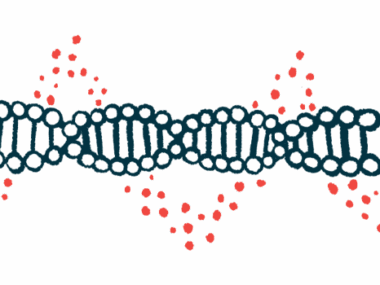New RNA-targeting Therapy Reduces Toxic HTT Protein Buildup
CRISPR-based therapy was designed to target the HTT gene’s messenger RNA
Written by |

Researchers have developed a new therapy that reduced the toxic buildup of the mutant huntingtin (HTT) protein — the hallmark of Huntington’s disease — in lab-grown neurons from Huntington’s patients and in a mouse model of the disease.
The CRISPR-based therapy was designed to specifically target the HTT gene’s messenger RNA (mRNA), the blueprint molecule derived from DNA that serves as a guide for making the HTT protein.
Treatment also led to improvements in the mice’s motor coordination, with benefits lasting at least eight months and without affecting mRNAs of other genes.
These findings support an mRNA-targeting CRIPSR therapy system as a potential targeted “therapeutic approach for HD [Huntington’s disease],” the researchers wrote.
The study, “An RNA-targeting CRISPR–Cas13d system alleviates disease-related phenotypes in Huntington’s disease models,” was published in Nature Neurosciences.
Huntington’s disease is a genetic disorder caused by excessive repeats of a portion of DNA, called CAG triplets, within the HTT gene. Excessive CAG repeats lead to a longer-than-normal huntingtin protein being produced that forms toxic clumps inside nerve cells, triggering their death.
“These repeats can sometimes grow to many times their normal length, with the resulting repeat-expanded protein tending to aggregate and form toxic clumps in a part of the brain called the striatum that’s important for regulating movement,” Gene Yeo, PhD, the study’s senior author at University of California (UC) San Diego, said in a university press release.
“The loss of functional neurons in the striatum ultimately leads to HD [Huntington’s disease] symptoms,” said Yeo, who is a professor of cellular and molecular medicine at UC San Diego’s School of Medicine.
While current therapies for Huntington’s aim to reduce symptoms, the major focus in its therapeutic development has shifted to target the root of the disease and prevent or slow disease progression.
But developing effective therapies has been challenging. Past clinical trials of two promising gene therapies in 2021 were halted due to a lack of effectiveness.
“The Huntington’s community was devastated when the clinical trials failed, primarily due to target specificity and toxic effects,” Yeo said. “But their termination has only re-energized the scientific community to find alternative strategies.”
One of the strategies is genome editing technologies such as CRISPR/Cas9, a system adapted from the natural defense mechanisms of bacteria that allows scientists to edit, insert, or delete DNA sequences with precision, efficiency, and flexibility.
This may lead to off-target edits, however, meaning it can cause alterations in the DNA that were not intended. To circumvent this problem, scientists have been working on a CRISPR system that targets the mRNA, without altering the genome.
“The RNA-guided, RNA-targeting subtype of … CRISPR–Cas, Cas13d, has been recently identified as an efficient and specific RNA-targeting approach that can be applied in mammalian cells,” the researchers wrote.
Targeting mutated HTT mRNA
Yeo’s team, along with colleagues at UC Irvine and Johns Hopkins University, assessed the effects of a new CRISPR–Cas13d-based therapy they designed to target the mutated HTT mRNA. It used a modified and harmless adeno-associated virus (AAV) to deliver the molecular machinery to cells.
The team first tested the therapy in lab-grown striatum-like neurons generated from induced pluripotent stem cells (iPSCs) of three Huntington’s patients. Of note, iPSCs are derived from either skin or blood cells and reprogrammed back into a stem cell-like state to generate an unlimited source of almost any type of human cell.
“Our goal was to engineer a type of therapy that would only target the toxic RNA that causes HD and could keep the rest of the human [DNA and mRNA] intact,” said Kathryn Morelli, PhD, the study’s co-first author and a research fellow in Yeo’s lab. “We specifically screened our top therapeutic constructs in HD patient cell lines to make sure of it.”
Results showed the therapy reduced the levels of mutant HTT mRNA by 56.2–84.1% in lab-grown, patient-derived striatal-like neurons. Only the mutant HTT mRNA was targeted, while other mRNAs were left untouched, researchers found.
The therapy worked in lab-grown cells from patients with either shorter CAG repeats (46–67) — most common with adult-onset Huntington’s — or longer repeats (66–109), most typical in juvenile-onset Huntington’s.
“These data support the broad utility of [the therapy] for patients with adult- or juvenile-onset HD-relevant CAG repeat lengths in mutant HTT,” the researchers wrote.
The therapy also significantly reduced the levels of mutant HTT clumps, highlighting that the new RNA-targeting approach “can selectively suppress mutant HTT aggregates,” they wrote.
The team then evaluated the effects of a single dose of the therapy in a Huntington’s mouse model.
They found the treatment improved the animals’ movement coordination, reduced striatum damage, and lowered the levels of toxic HTT clumps. These benefits lasted for at least eight months without off-target effects on other mRNA molecules.
Also, when analyzing changes in other mRNAs normally induced by the mutated HTT protein, the researchers saw more than half (56%) of these changes were reversed. Specifically, they showed a change of at least 50% toward levels found in healthy mice.
Also, 60.2% of the most robust Huntington’s-associated gene activity changes “were partially to fully reversed, including most of previously reported striatum-specific HD disease,” the researchers wrote. “Taken together, these results support the efficacy and safety of [the new therapy] in HD preclinical models.”
The researchers said their findings also have therapeutic implications for treating other neurodegenerative disorders.






